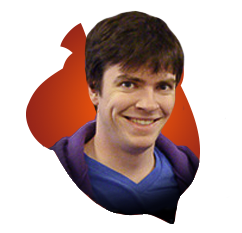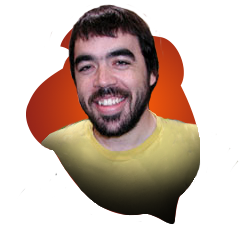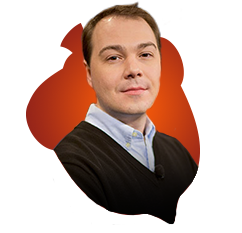The Un-Ending Saga, Part 1
The first Unstable preview week is next week, but I have so many stories to tell that I've decided to begin a week early. Note that means I'm not giving away any mechanical stuff today, but there's so much to the story that I won't even get to the part where we start making the stuff that ended up in the set until next week anyway (well, at least not in the form that ended up in print). With that caveat out of the way, it's finally time to begin telling the story of Unstable's design.
Unstable owes its existence to the Council of Marks. You see, there are a lot of Marks who work on Magic. Just in R&D, there's me, Mark Gottlieb, Mark Globus, Mark Winters, and Mark Heggen. Mark Purvis works in Brand. Mark Price works in Sales. Mark Racine works in Finance. Rumor has it we formed a secret illuminati group that controls the game. While that may or may not be true, the Council of Marks was instrumental in making Unstable happen, in particular Mark Purvis, Mark Globus, and myself.
Mark Purvis is a Magic senior brand director. Technically, I believe he's the senior director of global brand strategy and marketing for Magic. Mark has worked on the Magic brand team longer than anyone save Vice President Elaine Chase. Mark was a player for many years before he worked at Wizards, and his favorite sets were the Un- sets. He's shared numerous stories with me of fun moments with his friends involving Un- card shenanigans. He and I have talked about trying to make a third Un- set for years.
Mark Globus is the director of product design in Magic R&D. He's the one who connects with the many other facets of the company to make sure that everyone's on the same page as R&D regarding the vision of each set. Mark and I interact often in our respective roles making new Magic sets. One of Mark's responsibilities is coming up with product ideas for new sets. From time to time, Mark and I talked about the Un- sets, and he could sense my passion to make another one. He agreed with me that there was an audience for such a product.
And there's me. For those who might be unaware, the Un- sets are obviously my babies. Back in 1997, Bill Rose and Joel Mick came to me with an idea they had for a set. It would have silver borders and not be tournament legal. I was the most out-of-the-box of the designers. What could I do with that premise?
I was inspired by three things. One was my comedy writing background. I saw this set as an opportunity for Magic to poke fun at itself and dip its toe into some humor that normal Magic sets just couldn't do. Two, I had come up with numerous designs that the game rules couldn't handle. It wasn't that the players couldn't play them, but rather there were nuances in the rules that made them not technically work even if they practically could. Three, in my youth I was an amateur magician (you can learn more about this here). One of the products that fascinated me most was a deck of cards where each card had its own weird quirk. There was a three and a half of clubs and a black ten of diamonds and a card that was half jack of spades, half queen of hearts. The idea of the deck was that it introduced weird elements that left up to the magician how best to use them. I thought it would be neat to have a Magic set that did something similar. This is why the set had things like the first full-art lands, the first token creature cards, and the first cards designed specifically for multiplayer play.
A year later, I made a sequel to Unglued, called at the time "Unglued 2: The Obligatory Sequel," that would get shelved and never printed. You can see elements of it in my two "Un-Seen" columns ("Un-Seen" and "Un-seen 2: Electric Bugaloo").
Five years later, I would lead the design for Unhinged, the second Un- set released. No single person has been more involved in the creation of Un- sets than me, so if a third one was going to happen, I was definitely going to be involved.
The Problem at Hand
The head designer, a senior brand director, and the director of product design all wanted a third Un- set to happen. How could this possibly be a problem? To explain that, let's talk a little bit about the business side of the previous Un- sets.
Unglued premiered at Gen Con 1998. It was the site of the only Prerelease in the world and we ran numerous flights over the series of three days. This was the event where I famously head judged dressed as a chicken.

Unglued was a huge hit, with all the flights selling out. The buzz was so big that when I returned to the office, I was told I was to immediately start work on a second Un- set (what would become "Unglued 2: The Obligatory Sequel"). Initial sales were strong, but over time we started to see a glut in the market. In the end, we had to destroy product. Unglued 2 was put on permanent hiatus. Six years later, Unhinged was released. It followed a similar pattern. High interest out of the gate, but we didn't end up selling all the product we'd printed, and in the end, we had to again destroy product. The prevailing wisdom at the company was that the sets were failures and there was no reason to ever print another. That's what we were up against.
Mark Purvis believed that interpretation was wrong, though. You see, both Unglued and Unhinged predated us printing supplemental sets on a regular basis. His hypothesis was that the brand team at the time treated them like they were small expansions, as that was the closest thing to them that we made. The Un- sets failed not because there wasn't an audience, but because they were overprinted. They weren't treated like a supplemental set. Mark did a lot of work to prove the math behind his assertion.
Mark Globus, meanwhile, was focused on how to make an Un- set in a world where no one higher up was interested in doing one. His idea was rather ingenious. What if the creation of the third Un- set had a goal other than just making a set for print? What if it had a secondary reason for existing? Here was his plan: Wizards works with various printers to print all the Magic cards. New technology in printing was changing what was possible. What if we had a special team dedicated to exploring the new design space that the potential future of printing technology offered us? And what better set than one that defined itself by testing out new boundaries?
The third Un- set would be an experimental design that did what Un- sets do best: test out the future. Remember that many Magic innovations—from full-art lands to creature tokens to multiplayer cards to split cards to the meld mechanic to the forecast mechanic to the Pact cycle—came about because the Un- sets pushed new boundaries that later ended up being fruitful space for Standard-legal black-border sets.
Mark Globus also knew that a completed design was much easier to sell than a non-existent one. Magic is constantly evolving and changing, and numerous times opportunities pop up that require fast answers. Having a completed design in our pocket allowed us to take advantage of those opportunities when they arose. I was asked to put together a design team. It was a low-priority team (remember, I was still actively leading design for Standard-legal sets), so I had fewer resources but a greater amount of time to work.
Here's the team I put together. A quick aside before I introduce them—none of my original design team still works at Wizards. (Ian Duke is still here, but he was brought in late in the process.) So much time has elapsed that they've all gone on to do other things at other game companies. They've had to patiently sit by for years waiting for a product they worked on to finally see the light of day. (I would get the occasional text saying, "Any time soon?")
Dan Emmons

Dan started at Wizards in Game Support. His real goal, though, was to work in R&D designing Magic. He told me this when he came up to meet me during his first week at the company. He had submitted a lot of designs in the second Great Designer Search, so numerous designers vouched for him and we started letting him fill holes and attend playtests. We liked his work and he graduated from that to working on some mini teams and eventually full-time design teams. As I was interested in training Dan, I made him my "strong second" on Unstable, meaning he was in charge of updating the file and was given extra responsibility in filling holes. Time has shown that many designers have trouble when trying to design Un- cards, as doing things we don't normally do doesn't come easy. Dan was a natural, though, and provided a lot of cards along the way. (I say a lot because, as you'll see, the design took a long time and evolved along the way.)
Billy Moreno

Billy was a Pro Tour player who was brought in to work in development. It turned out that he was also pretty good at design. I was eager to have a developer on my team, as I wanted to make sure our wackiness was keeping itself in bounds enough to be balanced, but having Billy meant that I got a development perspective while also having someone with a knack for making offbeat designs. Billy would go on to become the first lead developer for Unstable. The job would later pass to Dave Humpherys and eventually to Ben Hayes. Billy's quirky sensibility was a great addition to the team.
Monty Ashley

Monty Ashley first joined Wizards back in 1997 doing data input. He would eventually become editor of the Sideboard, a website and magazine dedicated to covering the Pro Tour. He then moved over to MagicTheGathering.com in 2003. He and I worked together a lot with my Making Magic column (Monty helped me do a lot of quirky articles back in the day), and I realized that he had a great sense of humor. Because of the low priority of the team, I was limited in the number of R&D members I got, so I was eager to find someone from elsewhere in the building, and Monty was the perfect fit. Unstable was the only design team Monty ever worked on, but I think in an alternative timeline he could have been on a lot more teams. His sense of humor proved to be a huge asset for the design.
Ian Duke

Unstable design went on for a couple years. Near the end, we realized that Billy was the best choice to be the lead developer, so he asked if he could swap out to allow him to get a fresh perspective before development began. Ian swapped in for Billy, making Ian the only member of the design team, other than myself, to still be working at Wizards. Ian is probably best known for doing commentary at the Pro Tour, but his day job is running the technical side of the Play Design team. (Erik and I have the corresponding roles on the Set Design and Vision Design teams, respectively.) Ian was only on the team for a short time, but helped a lot with getting the set into shape as a fun Draft experience.
Someday My Printing Will Come
When we started design, the goal was to explore what new printing technology might allow. We began by reading about all the new technologies being worked on. Here's some of the things that excited us the most:
Grouping of Cards – When we designed double-faced cards initially, we designed them such that you would get a double-faced card and then a single-faced card that you put into your deck that would summon the double-faced card. We ended up changing the mechanic because, at the time, we could only be guaranteed a 90% success rate of the two cards appearing together in a pack. Future technology would get that up to 100%. What could we do if we knew two cards always came together in a booster?
Relational Groupings – Imagine if we could program a booster pack such that it always had a certain percentage of various qualities. Current technology allows us to roughly control that with a single quality (what R&D calls the "as-fan"), but imagine that technology being able to perfectly control various elements and even have them share levels in conjunction with one another. We could build boosters that come thematically connected or have boosters that mix and match cards from different sets.
Flexible Rules Text – Imagine having a card that has unique rules text based on other qualities found in the booster pack. This would allow cards to have a flexibility never seen before, where a card's identity was formed not just by what it was but by what it associated with.
The design team dove deep and came up with all kinds of really cool and interesting cards. Unstable doesn't have any of those, though, as we got a little too ahead of technology. Even though the set took many years to finally make it to print, none of our grandiose ideas were viable at the time the set was printed. I like to think of this as having been advance work on the fourth Un- set.
Steampunk Rock
Our early experimentation did end up with something you all will see, though: the world and resulting tone of the design. We knew going in that we wanted this Un- set to have a cohesive creative treatment to take advantage of all our skills at worldbuilding. With digital printing we were making combos and mashing card elements together. We felt like mad scientists, and came up with the idea of a world filled with mad science. Steampunk had been on our short list for many years and there was no indication Magic was going to do it any time soon, so we embraced it as the backdrop of our set.
Obviously, Kaladesh would pop into existence a few years later. Magic Origins needed a home plane for Chandra, and a technology-themed world matched her outfit. The initial worldbuilding went over so well that we audibled into visiting the world a year later. This conflict would be one of the things that would later delay the release of Unstable. (I'll share more on this in future weeks.)
Once we embraced a steampunk world of mad scientists, there was a pink elephant in the room. This card:
Back in 2007, we'd made a set called Future Sight that had timeshifted cards in a weird futuristic frame from possible Magic futures. The plan was for us to occasionally print these cards to show that certain potential futures had to come to pass. One of these cards was called Steamflogger Boss, and it was created by the design team as a joke. It referenced things not currently in the game with made-up terminology. We just thought it was humorous and had no plans of following through, but then Aaron Forsythe made a huge tactical error. In a column (Aaron wrote the development column at the time), Aaron admitted it was just a joke and "assembling contraptions" wasn't something we ever planned to do. (Trivia: an earlier version of the card "erected monuments.")
Tell Magic fans something will never happen and all you do is ensure that they will constantly ask for it. Thus, contraptions became this mechanic constantly in the zeitgeist. Players were always asking me when we'd finally do it. They asked enough that I swore I'd do it before I retired. (Note that I have no plans of retiring anytime soon—I just said I'd do it before I retired, not that I'd retire once I did it.) I had tried to do contraptions in a black-border set, but never came up with something that seemed worthy of being called "contraptions." Also, I never made something that was a perfect flavor fit. Perhaps we could solve this problem without the limitations of the black-border rules. I was intrigued. (More on this next week.)
The Gangs Are All Here
Once we believed contraptions were going to be part of the set, it started to influence other aspects. For example, one of my goals with Unstable was embracing new design technology. To accomplish this, I was looking for elements that had been created after Unhinged. One of those was factions. I liked the idea that this world would have different types of mad scientists, and set out to create different factions. To allow some flexibility in the draft, I decided I wanted two-color factions. I hadn't yet stumbled upon asymmetric factions (as seen in Ixalan), so I was stuck choosing either ally factions or enemy factions. The thing that tipped the scale was Steamflogger Boss.
I was insistent that we reprint Steamflogger Boss (the idea of putting him on the land sheet came quickly), which meant that one of our factions needed to be Goblins. Because each faction needed to have monocolored versions in both colors, I looked at what would make the best second color for the Steamfloggers, as the faction was originally called. Both mono-white and mono-blue felt wrong for Goblins. Black felt a little too mean, so I ended up with green, which meant we were doing ally factions.
The key to the factions was finding different groups that would want to build inventions. Inspired by Esper from Shards of Alara, I liked the idea of cyborgs that used the technology to improve themselves, just with a slightly more humorous bent. The cyborgs felt like they needed to be part blue, so we had to decide between white-blue and blue-black. I wanted the faction to have an "artifacts matter" component (remember, contraptions were defined as artifacts in the rules when Future Sight came out), and that pushed me more toward white-blue.
Blue-black wanted to be a faction that used the technology to be sneaky, so we ended up with a faction of spies. This allowed us to make fun of the tropes of elaborate spy gadgets. Black-red needed to be inventing things that would lead to destruction and chaos. After some experimentation, we settled on supervillains. The mad scientist supervillain was a fun trope space for us to play around in.
This left green-white. We liked the idea that their science was more about biology than metal, so we started playing around with the idea of weird animal humanoids and ended up with weird animal hybrids. This faction really took off after the worldbuilding, where the artists had great fun mixing and matching animals.
Many Challenges Ahead
So, we had our world and we had our factions. All we had to do now was figure out contraptions, find another mechanic, and make a lot of quirky cards. Good thing we had a few years to go. I normally love feedback, but as Unstable is a passion project of mine, I'm even more eager to hear what you all think. You can email me or talk to me through any of my social media accounts (Twitter, Tumblr, Google+, and Instagram).
Join me next week when I explain how contraptions were designed and how they actually work.
Until then, may you never give up in your quest to make your dream become a reality.
#484: Early Magic Evolution
#484: Early Magic Evolution
32:28
In this podcast, I explore Magic's early sets and talk about the design innovations each one brought.
#485: HASCON 2017
#485: HASCON 2017
35:45
The very first Hasbro-centric convention, called HASCON, was held in August. I was there, and this podcast is all about it.
- Episode 483 Ixalan, Part 3 (21.0 MB)
- Episode 482 Ixalan, Part 2 (19.9 MB)
- Episode 481 Ixalan, Part 1 (24.7 MB)

